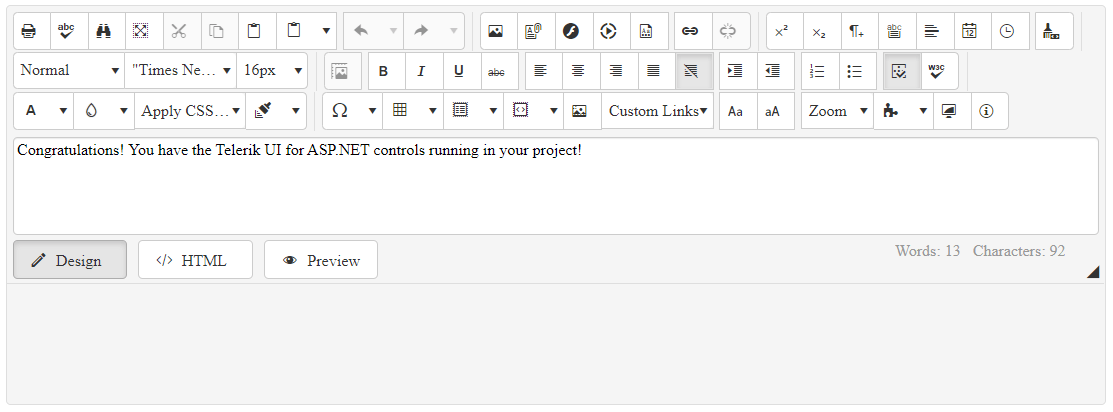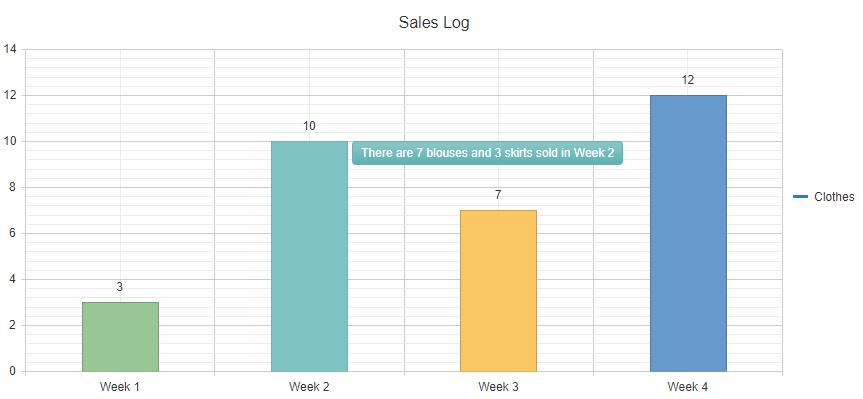First Steps by Installing with a ZIP File
The Telerik UI for ASP.NET AJAX library provides an option for installing its controls by downloading and executing the ZIP file, which contains the suite.
The ZIP file is used to manually install, upgrade, or update the suite in your web application or website. To proceed with the ZIP installation, you need to be familiar with ASP.NET, IIS, setting permissions, and creating virtual folders. Commonly, the ZIP is installed directly in inetpub/wwwroot.
This tutorial describes how to get up and running with Telerik UI for ASP.NET AJAX by downloading and installing the controls from the ZIP file.
- First, you will install the Telerik UI for ASP.NET AJAX library from a ZIP file and run the demos.
- Next, you'll create your ASP.NET AJAX application and add the Editor control to it.
- Then, you will dive deeper by defining the HtmlChart control and binding it to sample data.
- Finally, you will add some styling to the controls.
What about a free Telerik UI onboarding course? Learn how to take advantage of the Telerik Virtual Classroom.
Prerequisites
The following prerequisites are required for accomplishing the scenario in this tutorial. For more information on the third-party tooling versions supported by Telerik UI for ASP.NET AJAX, refer to the list with system requirements.
Install ASP.NET AJAX on your development or production machine. ASP.NET AJAX is available in the .NET 4.x+ installations.
If a new user, create a Telerik account.
Step 1: Install Telerik UI for ASP.NET AJAX
After successfully providing the prerequisites, you will install the suite from the ZIP file without IIS running:
Log into your Telerik account and click Downloads from the top menu.
On the loaded page choose from your purchased products or trial downloads Telerik® UI for ASP.NET AJAX, and click on it.
Download the Manual installation (
Telerik_UI_for_ASP.NET_AJAX_20xx_x_xxx_Dev.zip) file and extract its content to a convenient location.
Unlike the Telerik UI for ASP.NET AJAX MSI package installation, the Zip package does not automatically add the UI components to the Visual Studio toolbox. To add them manually, refer to the article on adding the Telerik controls to the Visual Studio toolbox.
Additionally, the zip does not install the Visual Studio Extensions for Telerik® UI for ASP.NET AJAX, which are valuable tools for WebForms developers working with the Telerik ASP.NET Web Forms components. However, these extensions can be downloaded and installed as a separate product from the Visual Studio Gallery.
Step 2: Upgrade an Existing Telerik UI for ASP.NET AJAX Project
The files from the ZIP installation are usually used for manual upgrading of an already existing Telerik UI for ASP.NET AJAX Project. The following steps ensure a safe upgrade:
Back up your project.
Delete the old
Telerik.Web.UI.*references from the project and close it. As with any ASP.NET project, it is helpful to clear the ASP.NET Temporary files and the browser cache.Open the Bin folder of your project in Windows Explorer and delete the old
Telerik.Web.UI.*assemblies.-
Copy the new assemblies from the
Bin462folder in the UI for ASP.NET AJAX installation path and paste them to theBinfolder of your project.You can use the copy-and-replace method to upgrade any other assemblies, localization files (
~/App_GlobalResources), dialogs (ImageEditor, Editor), TypeScript definitions, and so on. Open the project in Visual Studio and add references to the Telerik assemblies.
Make sure you have all necessary
web.configregistrations.
Step 3: Add the Editor to Your Project
The Web Forms Site created through the Telerik project templates includes all basic references and registrations required by the Telerik UI for ASP.NET AJAX controls, including a ScriptManager control, which is required by all AJAX controls. That's why you can add the Editor to the page in a simple way as demonstrated in this step.
Alternatively, you can add the Editor to your project by dragging it directly from the VS toolbox. For more information, refer to the article on adding the Telerik controls to the Visual Studio toolbox.
-
Open
Default.aspxand declareRadEditorright afterRadScriptManager:<telerik:RadScriptManager ID="RadScriptManager1" runat="server"></telerik:RadScriptManager> <telerik:RadEditor runat="server" ID="RadEditor1" </telerik:RadEditor> -
Set the
RenderModeandContentproperties of the Editor:<telerik:RadScriptManager ID="RadScriptManager1" runat="server"></telerik:RadScriptManager> <telerik:RadEditor runat="server" ID="RadEditor1" RenderMode="Lightweight"> <Content> Congratulations! You have the Telerik UI for ASP.NET controls running in your project! </Content> </telerik:RadEditor> Run your page by pressing
F5.
Add the Editor to the page

Step 4: Add the HtmlChart to Your Project
Let’s dive a little bit deeper in the configuration of the controls from the UI for ASP.NET AJAX suite. By following the steps below, you will create a data-bound HtmlChart. You will also add a handy tooltip that shows the values from a custom data field.
The sample uses a DataTable, but you can bind the HtmlChart to a preferred data source type. The page already contains a ScriptManager control, so you are ready to declare the HtmlChart right after the Editor control that you added in the previous step:
-
In
Default.aspx, define an HtmlChart withID="RadHtmlChart1":<telerik:RadHtmlChart ID="RadHtmlChart1" runat="server"> </telerik:RadHtmlChart> -
Add a
ChartTitleto the created HtmlChart:<telerik:RadHtmlChart ID="RadHtmlChart1" runat="server"> <ChartTitle Text="Sales Log"></ChartTitle> </telerik:RadHtmlChart> -
Add
ColumnSeriesto thePlotArea.Seriescollection of the control:<telerik:RadHtmlChart ID="RadHtmlChart1" runat="server"> <ChartTitle Text="Sales Log"></ChartTitle> <PlotArea> <Series> <telerik:ColumnSeries Name="Clothes"></telerik:ColumnSeries> </Series> </PlotArea> </telerik:RadHtmlChart> -
In the code-behind of the page, create a
GetData()method. This method returns the sample data that you will bind to the chart:private DataTable GetData() { DataTable dt = new DataTable(); dt.Columns.Add("labels"); dt.Columns.Add("values"); dt.Columns.Add("colors"); dt.Columns.Add("description"); dt.Rows.Add("Week 1", 3, "#99C794", " 1 blouse and 2 trousers"); dt.Rows.Add("Week 2", 10, "#5FB3B3", "7 blouses and 3 skirts"); dt.Rows.Add("Week 3", 7, "#FAC863", "7 skirts"); dt.Rows.Add("Week 4", 12, "#6699CC", "5 blouses, 5 trousers and 2 skirts"); return dt; } ````Private Function GetData() As DataTable Dim dt As DataTable = New DataTable() dt.Columns.Add("labels") dt.Columns.Add("values") dt.Columns.Add("colors") dt.Columns.Add("description") dt.Rows.Add("Week 1", 3, "#99C794", " 1 blouse and 2 trousers") dt.Rows.Add("Week 2", 10, "#5FB3B3", "7 blouses and 3 skirts") dt.Rows.Add("Week 3", 7, "#FAC863", "7 skirts") dt.Rows.Add("Week 4", 12, "#6699CC", "5 blouses, 5 trousers and 2 skirts") Return dt End Function ```` -
Configure the data source of the chart to use the created sample data:
protected void Page_Load(object sender, EventArgs e) { if (!IsPostBack) { RadHtmlChart1.DataSource = GetData(); } } ````Protected Sub Page_Load(ByVal sender As Object, ByVal e As EventArgs) Handles Me.Load If Not IsPostBack Then RadHtmlChart1.DataSource = GetData() End If End Sub ```` -
Set the
colorsandvaluesfield names to the SeriesDataFieldYandColorFieldproperties:<telerik:RadHtmlChart ID="RadHtmlChart1" runat="server"> <ChartTitle Text="Sales Log"></ChartTitle> <PlotArea> <Series> <telerik:ColumnSeries Name="Clothes" DataFieldY="values" ColorField="colors"></telerik:ColumnSeries> </Series> </PlotArea> </telerik:RadHtmlChart> -
Set the
labelsfield name to thePlotArea.XAxis.DataLabelsFieldvalue:<telerik:RadHtmlChart ID="RadHtmlChart1" runat="server"> <ChartTitle Text="Sales Log"></ChartTitle> <PlotArea> <Series> <telerik:ColumnSeries Name="Clothes" DataFieldY="values" ColorField="colors"></telerik:ColumnSeries> </Series> <XAxis DataLabelsField="labels"></XAxis> </PlotArea> </telerik:RadHtmlChart> -
Define a
TooltipsAppearancenested tag in the series declaration. Then define a custom Tooltip template in it. All fields from the passed data source are available through thedataItemobject of the template:<telerik:RadHtmlChart ID="RadHtmlChart1" runat="server"> <ChartTitle Text="Sales Log"></ChartTitle> <PlotArea> <Series> <telerik:ColumnSeries Name="Clothes" DataFieldY="values" ColorField="colors"> <TooltipsAppearance> <ClientTemplate> There are #=dataItem.description# sold in #=category# </ClientTemplate> </TooltipsAppearance> </telerik:ColumnSeries> </Series> <XAxis DataLabelsField="labels"></XAxis> </PlotArea> </telerik:RadHtmlChart> Run the page by pressing
F5. You are expected to see something similar to the following image:
Bound HtmlChart with a custom Tooltip template

Step 5: Style the Controls
Telerik UI for ASP.NET AJAX provides more than 20 predefined skins that allow you to change the look and feel of each component. To use the desired skin, set the skin name as the Skin property value of the control:
<telerik:RadEditor runat="server" ID="RadEditor2" Skin="Glow" RenderMode="Lightweight">
<Content>
Congratulations! You have the Telerik UI for ASP.NET controls running in your project!
</Content>
</telerik:RadEditor>
Apply the Glow skin to the Editor

That was it! Now you are ready to dive more deeply into Telerik UI for ASP.NET AJAX and take full advantage of its slick functionalities!